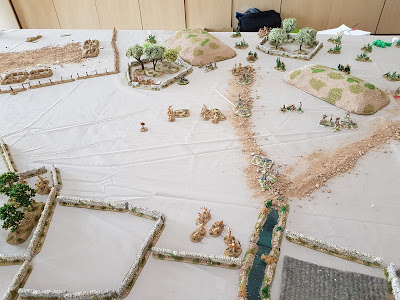At first light, waves of Italian and German bombers and fighters began a massed attack, targeting British defences and suspected troop concentrations, severely disrupting command and control. As the last bombers turned for home, the defenders could already hear the distant droning of multi-engine aircraft approaching, fearing either another wave of bombers or transport aircraft. It turned out to be waves of Ju 52s carrying paratroopers.
The first Fallschirmjager platoon to land was dropped successfully in the area around the dry river beds, taking a few casualties due to hitting the dry stream beds or olive trees on landing, but generally landing in a relatively tight grouping. Most units spent the first turn occupied in locating landing canisters and preparing for the fight.
The second Fallschirmjager platoon landed in the next wave, some distance away from the airfield target. The jagers dropped in a tightly grouped mass, but some support weapons were badly scattered.
Finally, a platoon of Folgore landed from the 3rd wave, as close to the target airfield as they dared. They managed to land quite badly scattered, with many hitting the olive grove near the end of the runway and more landing in the orange and lemon groves near the village, although their losses were again light. Unlike Crete, the paratroopers had managed a successful drop.
The first Fallschirmjager platoon pushed towards the British defending the airfield perimeter, supported by the Folgore that had landed nearby. The remainder of the Folgore and second Fallschirmjager platoon pushed down towards the road and villages, in an attempt to isolate the airfield from reinforcements.
The British, well aware that a major landing was in progress, raced an anti-paratrooper patrol towards the airfield, which occupied the village closest to the airfield and sent out probes to locate and destroy the nearby Folgore.
Fallschirmjager from 2nd platoon approached the outskirts of the other village.
Axis troops securing a base for their heavy weapons in the gullies.
The British airfield defenders coming off worse in a firefight with Folgore and Fallschirmjager.
The British anti-paratrooper force secures the largest village nearest the airfield, although the squad sent to deal with the Folgore have been outflanked and need to retire.
Finally, the armoured support arrives for the British. One Vicker Mk VI light tank, an A13 and a Matilda II. Unfortunately, they all arrived on roads as far as possible from the airfield, but immediately went into action with the 2nd Fallschirmjager platoon, causing significant losses.
The British lorried infantry hold the village, keeping a route open to the airfield.
Sadly for the British, it was all too much for the defenders of the airfield and they were overrun, leaving the Axis forces in firm control and able to quickly repair superficial damage to the airstrip, albeit under harassing fire from British mortars until they were withdrawn to bolster the second line of defence.
Overall paratrooper losses were relatively heavy, although they were often able to withdraw even single man units (lone survivors) without further loss or suppression, thus avoiding the need to take a chit. The British defenders of the airfield were also heavily hit and largely destroyed. The anti-paratrooper platoon was relatively unscathed, as were their armoured support, which was already indicating how effective they would be against the paratroopers as they lacked any heavy weapons to deal with them. Overall, plenty of Iron Crosses awarded to the Germans, surviving Folgore decorated so heavily with medals they could no longer walk, a couple of posthumous VCs, MCs and MMs to the airfield defenders and some solid lessons learned for the British.
Great fun, thanks to Mike, Will and Kevin (the dastardly Hun and spaghetti eaters) and commiserations to Mike (airfield defence) - sadly, my anti-paratrooper infantry and armour were too slow to come to the aide of the airfield defence.
Thanks for looking.















Excellent commentary Andy, except you forgot to mention the German determination to fight till the last Italian. Folgore fought well, just like they would at El Alamein
ReplyDeleteTrue, the Italians did more than their fair share of fighting, but it was the Fallschirmjager that stole the limelight around the airfield perimeter.
DeleteCheers, Andy